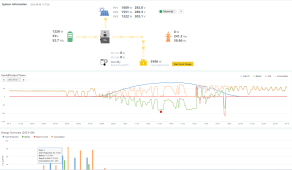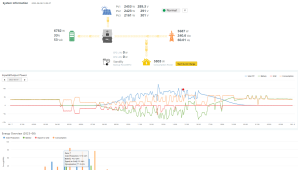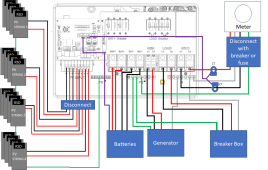You are using an out of date browser. It may not display this or other websites correctly.
You should upgrade or use an alternative browser.
You should upgrade or use an alternative browser.
EG4 18kPV Q+A general thread
- Thread starter SignatureSolarJames
- Start date
Mesquitemonkey
New Member
Thank you so much @FilterGuy for the diagrams. My small co-op has never seen a hybrid inverter before and did not understand how it worked. I hope you don't mind that I copied and pasted all your diagrams and explanation to send to my electric co-op to help them out. Great stuff. Thank you so much for the work to make them.
That’s the oneThis one:
View attachment 161568
That is essentially the same as "A" in post 1033. (I show the taps in a slightly different place, but logically they are the same)
The layout is fine.
FilterGuy
Solar Engineering Consultant - EG4 and Consumers
I am glad they are helpful.Thank you so much @FilterGuy for the diagrams. My small co-op has never seen a hybrid inverter before and did not understand how it worked. I hope you don't mind that I copied and pasted all your diagrams and explanation to send to my electric co-op to help them out. Great stuff. Thank you so much for the work to make them.
fromport
Solar Addict
Is B really a safe option?
Normally the wires that supply the meter are rated for the max amp of the main breaker of your panels
Let's assume there is a 200 amp breaker in the main panel.
That way if more than 200 amps is being pulled from the grid -> breaker trips.
With supply side GRID TIED solar only, nothing changes.
Any PV will help supply (instead of only the utility company) up to 200 amps combined.
With your diagram, assume at night: no PV support: the AIO has empty batteries and are being charged by the grid and critical load is running.
Now if the non-critical load also starts to pull (eg EV charging) so could technically pull more than 200 amp through the meter from the grid.
That could mean that the supply wires could get in overload situation.
From what I understood, supply side hookup can _only_ deliver energy, never pull energy.
So imo the B option is not a wanted/allowed scenario.
Even though you would need to pull a lot of power from the non-critical load & pull extra on the supply side connection in order to go over the 200 amp rating, it is technically possible and that could be a liability/hazard.
Like to hear your view on this.
Cheap 4-life
My body is 2.63 trillion volts, .07v per cell
I agree.Is B really a safe option?
Normally the wires that supply the meter are rated for the max amp of the main breaker of your panels
Let's assume there is a 200 amp breaker in the main panel.
That way if more than 200 amps is being pulled from the grid -> breaker trips.
With supply side GRID TIED solar only, nothing changes.
Any PV will help supply (instead of only the utility company) up to 200 amps combined.
With your diagram, assume at night: no PV support: the AIO has empty batteries and are being charged by the grid and critical load is running.
Now if the non-critical load also starts to pull (eg EV charging) so could technically pull more than 200 amp through the meter from the grid.
That could mean that the supply wires could get in overload situation.
From what I understood, supply side hookup can _only_ deliver energy, never pull energy.
So imo the B option is not a wanted/allowed scenario.
Even though you would need to pull a lot of power from the non-critical load & pull extra on the supply side connection in order to go over the 200 amp rating, it is technically possible and that could be a liability/hazard.
Like to hear your view on this.
there should be a breaker sized for the inverters pass thru capability and the main panels possible load. That breaker should be before the inverters service tap. That also means the wires from the meter should be sized accordingly
fromport
Solar Addict
Or the main breaker of the main panel and the fuses/breaker of the supply disconnect added together should not be more than the original main breaker capacity, eg the 200 amp I gave in my example. But that kind of defeats the whole purpose of a 200 amp pass through.I agree.
there should be a breaker sized for the inverters pass thru capability and the main panels possible load. That breaker should be before the inverters service tap. That also means the wires from the meter should be sized accordingly
Cheap 4-life
My body is 2.63 trillion volts, .07v per cell
the wire from the meter could simply be sized to handle the amps the inverter could pass through and the amps of the main panel. Then no additional breakers would be needed other than the two breakers Option B already shows. Although changing out the wire from the meter for a larger gauge would require the electric companies disconnection of the homes serviceOr the main breaker of the main panel and the fuses/breaker of the supply disconnect added together should not be more than the original main breaker capacity, eg the 200 amp I gave in my example. But that kind of defeats the whole purpose of a 200 amp pass through.
Last edited:
Cheap 4-life
My body is 2.63 trillion volts, .07v per cell
But then the wire before the meter would also have to be sized accordingly 400amps! So honestly option B is not an option if the user wants to take advantage of the inverters 200amp pass thru capability. Unless most of the loads are removed from the main panel..
Last edited:
fromport
Solar Addict
Exactly what I was getting at!
Beetle Bailey
New Member
Does anyone else have huge fluctuations in Solar production. You can see it in the graph all of the spikes and dips. Before the FW update I had a nice smooth arc and that was my best production day. Now my Grid input and Solar at times are all over the place. I'll have almost 4k of input in all 3 arrays with nothing coming in on the grid. Then all of the sudden Solar will drop to 1.5k per array and Grid input will be 4.5k and it will seesaw after that for a while. I'm in North Texas with no clouds ( or rain....) so I know it's not that.
The smooth Solar arc is stock out of the box, the jagged is after an update.


The smooth Solar arc is stock out of the box, the jagged is after an update.


cs1234
Solar Wizard
- Joined
- May 9, 2022
- Messages
- 2,591
@Beetle Bailey
Disclaimer: I'm not using any EG4 equipment.
It looks kind of like there aren't as many dots on the second picture solar curve as the first. Maybe they changed something with how often it polls / saves the data for the report?
My solar production in Texas is all over the place during the day, even seemingly cloudless skies aren't really cloudless. With less data points, it could easily look like that if it catches it at brief cloud cover moments.
Disclaimer: I'm not using any EG4 equipment.
It looks kind of like there aren't as many dots on the second picture solar curve as the first. Maybe they changed something with how often it polls / saves the data for the report?
My solar production in Texas is all over the place during the day, even seemingly cloudless skies aren't really cloudless. With less data points, it could easily look like that if it catches it at brief cloud cover moments.
Zapper77
Renaissance Man
- Joined
- Jul 23, 2022
- Messages
- 2,344
Do you have charge first enabled and what limit did you set for charging?Does anyone else have huge fluctuations in Solar production. You can see it in the graph all of the spikes and dips. Before the FW update I had a nice smooth arc and that was my best production day. Now my Grid input and Solar at times are all over the place. I'll have almost 4k of input in all 3 arrays with nothing coming in on the grid. Then all of the sudden Solar will drop to 1.5k per array and Grid input will be 4.5k and it will seesaw after that for a while. I'm in North Texas with no clouds ( or rain....) so I know it's not that.
The smooth Solar arc is stock out of the box, the jagged is after an update.
View attachment 161682
View attachment 161683
Beetle Bailey
New Member
Charge first is not enabled. As for the limit, are you talking about the Charge Current Limit (Adc)? That currently is set to 250.Do you have charge first enabled and what limit did you set for charging?
Beetle Bailey
New Member
When I had my 6500's, Solar production was pretty rock solid when it was sunny. Very few fluctuations in charging at that time and I would get typically over 3.5Kw mid day from each of the 3 arrays. Just seems to be more erratic with the last update I had. Than again, it could be the settings.@Beetle Bailey
Disclaimer: I'm not using any EG4 equipment.
It looks kind of like there aren't as many dots on the second picture solar curve as the first. Maybe they changed something with how often it polls / saves the data for the report?
My solar production in Texas is all over the place during the day, even seemingly cloudless skies aren't really cloudless. With less data points, it could easily look like that if it catches it at brief cloud cover moments.
Markus_EG4
I am from Germany. Don't mean to come off rude
What Firmware did Gilbert put on your inverter. We had one that would not read correctly in the monitoring system thats why we never released it.When I had my 6500's, Solar production was pretty rock solid when it was sunny. Very few fluctuations in charging at that time and I would get typically over 3.5Kw mid day from each of the 3 arrays. Just seems to be more erratic with the last update I had. Than again, it could be the settings.
Beetle Bailey
New Member
I believe it was 0E0EWhat Firmware did Gilbert put on your inverter. We had one that would not read correctly in the monitoring system thats why we never released it.
Searched and tried to read manually through this giant thread but didn't have any luck. I just got the 18k today to replace 2x6500. Moved all the wiring over and couldn't get the batteries to communicate (4xEG4). Found the thread on needing to upgrade the firmware on those. Changed the battery type to lead acid as per the manual to get things going.
The real issue is that the batteries are fully charged but none of the solar is being used for the house loads. Using it with the critical loads panel and have not installed the CTs. No grid export. I must be missing the option to have it actually use the solar/batteries for loads! I did test it with just the batteries before turning on the grid input and it could power things and I saw the correct voltage between the legs.
The real issue is that the batteries are fully charged but none of the solar is being used for the house loads. Using it with the critical loads panel and have not installed the CTs. No grid export. I must be missing the option to have it actually use the solar/batteries for loads! I did test it with just the batteries before turning on the grid input and it could power things and I saw the correct voltage between the legs.
Zapper77
Renaissance Man
- Joined
- Jul 23, 2022
- Messages
- 2,344
Connect the CTsSearched and tried to read manually through this giant thread but didn't have any luck. I just got the 18k today to replace 2x6500. Moved all the wiring over and couldn't get the batteries to communicate (4xEG4). Found the thread on needing to upgrade the firmware on those. Changed the battery type to lead acid as per the manual to get things going.
The real issue is that the batteries are fully charged but none of the solar is being used for the house loads. Using it with the critical loads panel and have not installed the CTs. No grid export. I must be missing the option to have it actually use the solar/batteries for loads! I did test it with just the batteries before turning on the grid input and it could power things and I saw the correct voltage between the legs.
Dang even for the critical load panel? Will do. Didn't realize it was required! Only held off so I could keep the AC onConnect the CTs
Similar threads
- Replies
- 43
- Views
- 3K
- Replies
- 4
- Views
- 189
- Replies
- 10
- Views
- 339
- Replies
- 16
- Views
- 601



